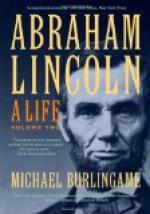But the proclamation was operative only upon certain individuals. The President’s emancipatory power covered only those persons (with, perhaps, their families) whose freedom would be a military loss to the South and a military gain to the North in the pending war. He had no power to touch the institution of slavery. That survived, for the future, and must survive in spite of anything that he alone, as President, could do. Nevertheless, in designing movements for its permanent destruction he was not less earnest than were the radicals and extremists, though he was unable to share their contempt for legalities and for public opinion. It has been shown how strong was his desire that legislative action for abolition should be voluntarily initiated among the border slave States themselves. This would save their pride, and also would put a decisive end to all chance of their ever allying themselves with the Confederacy. He was alert to promote this purpose whenever and wherever he conceived that any opportunity offered for giving the first impulse. In time rehabilitated governments of some States managed with more or less show of regularity to accomplish the reform. But it was rather a forced transaction, having behind it an uncomfortably small proportion of the adult male population of the several States; and by and by the work, thus done, might be undone; for such action was lawfully revocable by subsequent legislatures or conventions, which bodies would be just as potent at any future time to reestablish slavery as the present bodies were now potent to disestablish it. It was entirely possible that reconstruction would leave the right of suffrage in such shape that in some States pro-slavery men might in time regain control.
In short, the only absolute eradicating cure was a constitutional amendment;[77] and, therefore, it was towards securing this that the President bent all his energies. He could use, of course, only personal influence, not official authority; for the business, as such, lay with Congress. In December, 1863, motions for such an amendment were introduced in the House; and in January, 1864, like resolutions were offered in the Senate. The debate in the Senate




